This Beef Bulgogi Bowl recipe (bibimbap) makes a delicious one-bowl meal. It’s a super easy weeknight dinner. It features marinated, thin slices of tender beef cooked on a barbecue, griddle, or skillet and served over a bed of rice.

An assortment of vegetables and kimchi, and, if you like, a runny fried egg or soft-boiled egg on top, make this a full meal in a bowl.
This Korean beef bowl is a classic. The Korean BBQ beef recipe calls for marinating the beef in a soy sauce marinade that packs a flavorful punch. It combines grated pear, fresh garlic, green onions, rice wine, rice vinegar, and honey.
Marinating the beef for at least 30 minutes, or longer if time allows, infuses all of those flavors deep into the meat.
What is bibimbap?
Bibimbap literally translates from Korean as “mixed rice.” On a menu, it means a bowl of rice, often cooked until crisp on the bottom in a stone bowl, topped with an assortment of meat and vegetables.
Korean Beef Bulgogi Bowls are a great way to serve a complete, nutritious meal in a single bowl. My family loves them with a combination of raw, cooked, and pickled or fermented vegetables (kimchi) on top along with the bulgogi beef. We also often top them with a fried egg.
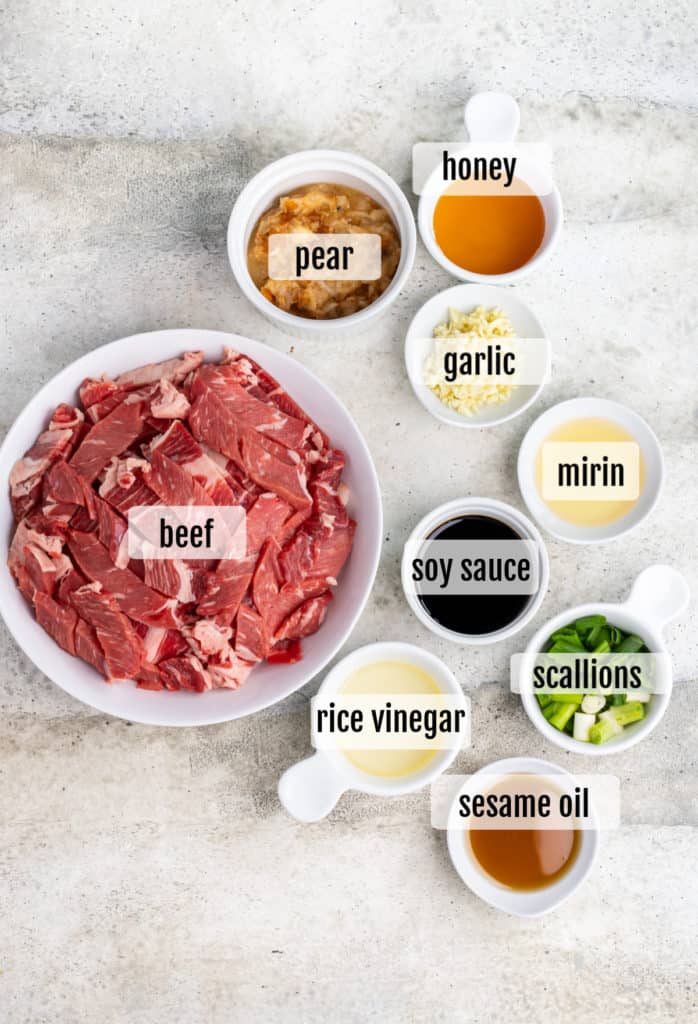
What ingredients do you need to make this bulgogi rice bowl recipe?
- Beef: Use a cut of beef that’s great for grilling, like rib eye. Thinly slice the meat before adding to the marinade.
- Pear: Bulgogi marinade usually includes a fruity element like a Korean pear. I use bosc pears because they’re easy to find in the US.
- Garlic: I recommend using fresh garlic that you mince yourself for the best flavor.
- Green onions: Sliced green onions or scallions add flavor and a splash of color.
- Dark soy sauce: Dark soy sauce is darker, thicker, and sweeter than regular or light soy sauce.
- Sesame oil: Use a Korean or Japanese style toasted sesame oil, and check the label to make sure it is 100 percent sesame oil rather than a blend of sesame oil and vegetable oil.
- Mirin: A sweet Japanese cooking wine. You can substitute Japanese sake or Korean shochu, or even white wine.
- Rice wine vinegar: Use unseasoned rice vinegar. You can substitute apple cider vinegar if necessary.
- Honey: Honey adds both flavor and sweetness. If you don’t have honey, substitute brown sugar, coconut sugar, or palm sugar.
- Sesame seeds: Toasted sesame seeds are an optional garnish.
- Rice: Use steamed white rice or substitute brown rice or Korean mixed grain rice. You can cook your rice on the stovetop, but I love using my Reishunger rice cooker.
- Vegetables: Use assorted vegetables, herbs, and pickles for garnish including cilantro, sliced cucumbers, grated carrots, sliced radishes, cooked spinach, marinated bean sprouts, and spicy kimchi (try this quick Cucumber Kimchi).
- Eggs: A fried egg is a traditional topping for a Korean rice bowl and is an optional addition here. Cook yours sunny side up or over easy, or substitute poached eggs or soft boiled eggs.
- Gochujang: This Korean fermented chili paste makes a great sauce for drizzling. You can substitute ssamjang, sriracha, or any spicy sauce for drizzling (optional). If you like, make the sauce from Korean Fried Chicken and drizzle over the rice bowl.
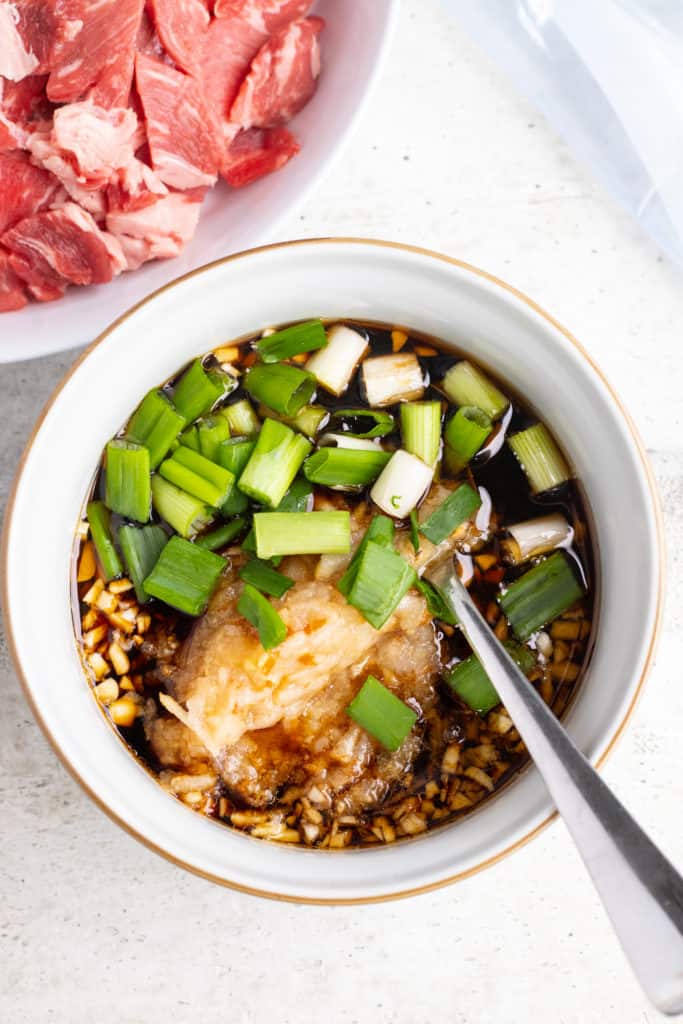
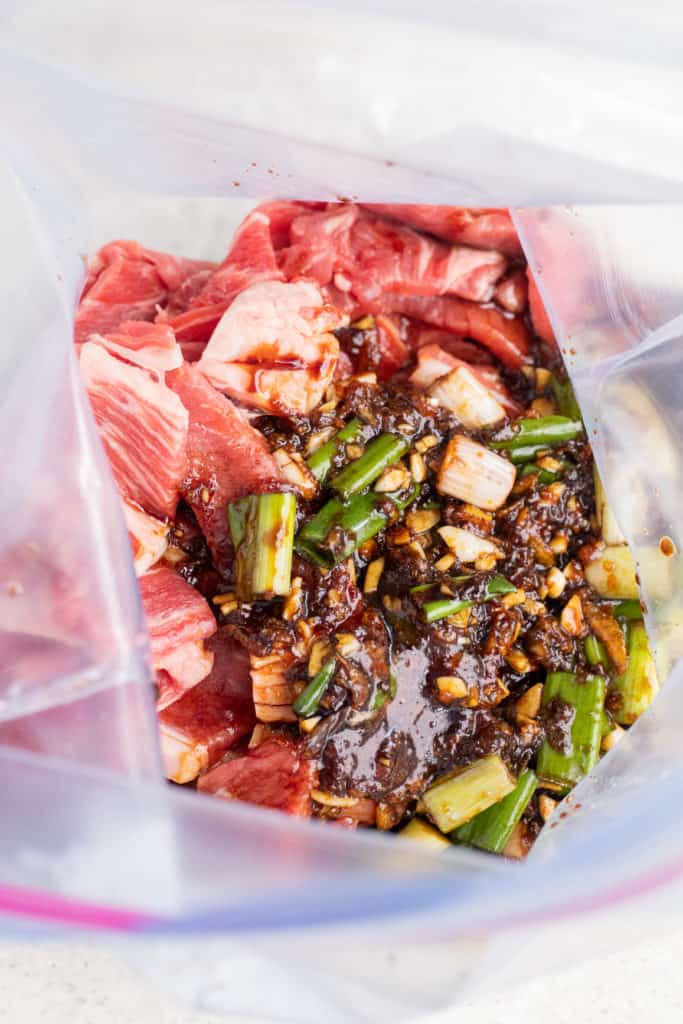


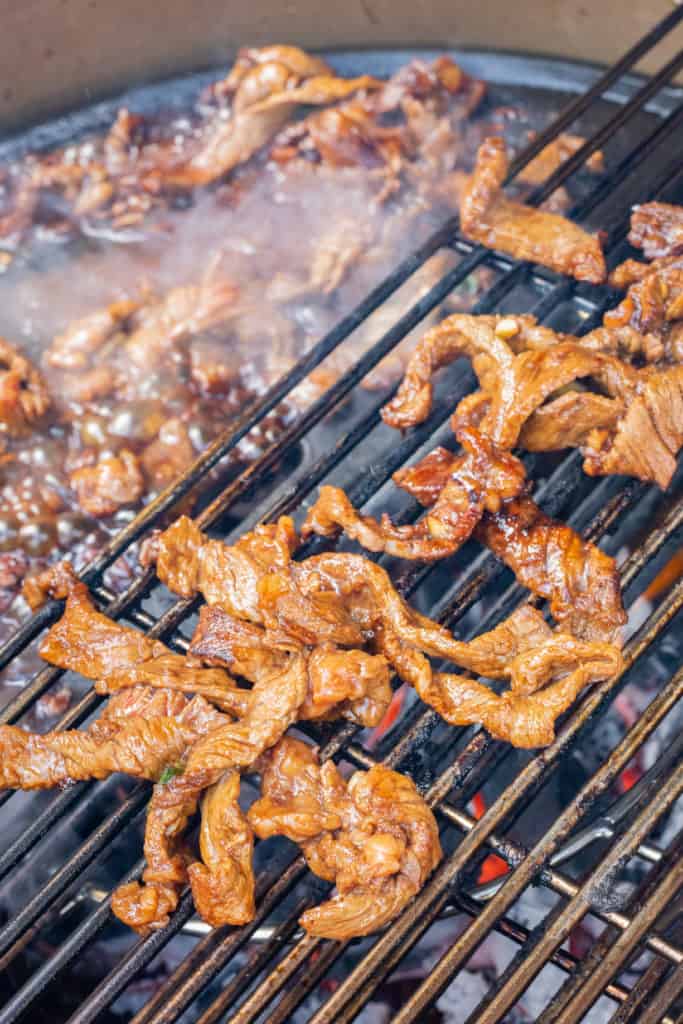
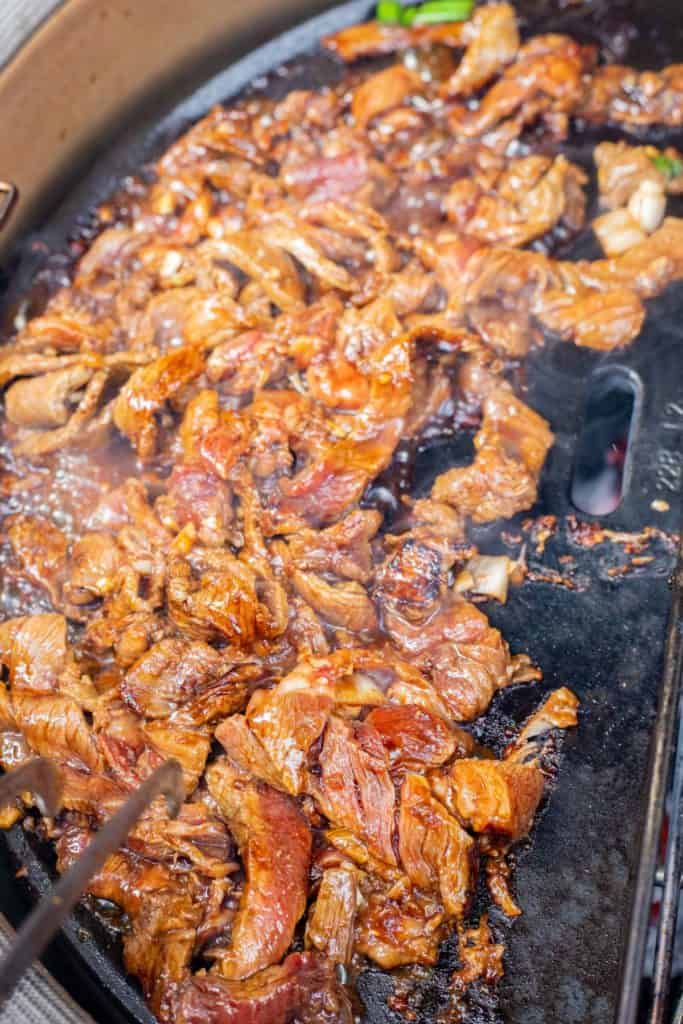
How to make it
- Mix the marinade ingredients together either in a large bowl or in a large Ziploc bag.
- Combine the sliced beef with the marinade and let stand for at least 30 minutes or as long as 24 hours (refrigerate if marinating for longer than 30 minutes).
- Make the rice and prep your vegetables.
- Make Cucumber Kimchi if desired.
- Preheat a BBQ, grill, griddle, or cast-iron skillet to medium-high heat.
- Cook the meat in a single layer, stirring frequently, just until it is cooked through and browned on the edges. This will take just about 30 seconds or so if the meat is thinly sliced. You can cook the meat in batches, transferring them to a plate as they are finished cooking.
- Just before serving, make fried eggs, if desired.
- Serve the cooked beef over a bowl of rice. Add the vegetables, fried eggs, and kimchi along with sesame seeds, sliced scallions, and a drizzle of sauce if desired.
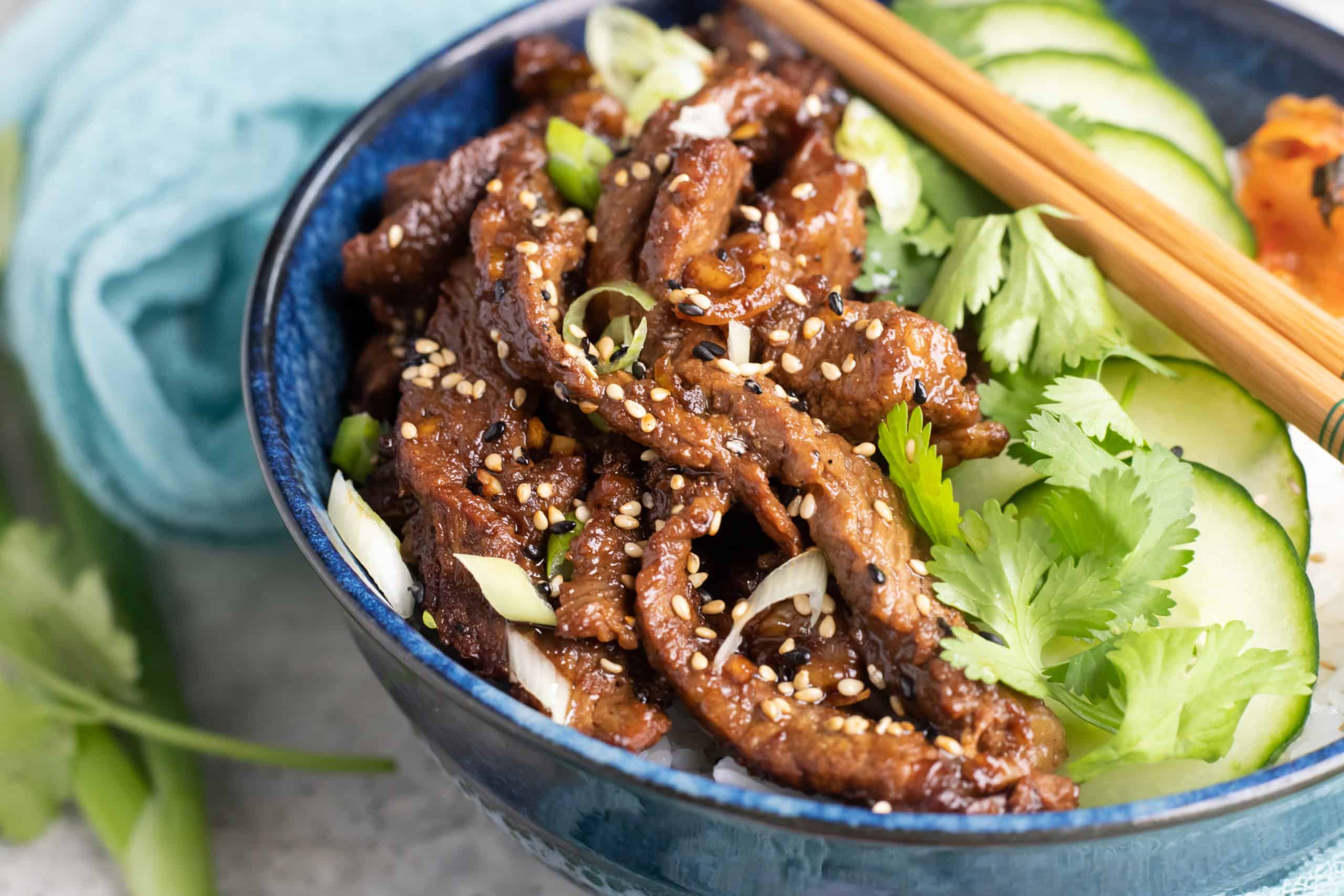
What to serve it with
This beef bulgogi bowl recipe makes a complete meal, so there’s really no need to serve anything else. If you want to make it a more authentic Korean dining experience, serve several banchan, or Korean side dishes, alongside.
I like to serve Cucumber Kimchi, Stir-Fried Lotus Root, and Japanese-Style Pickled Daikon as side dishes.
If you’re interested in exploring more Korean food, Korean Bapsang is a great Korean cooking blog that has lots of Korean BBQ recipes and recipes for Korean banchan like Sigeumchi Namul (Korean Spinach) and Musaengchae (Spicy Radish Salad).
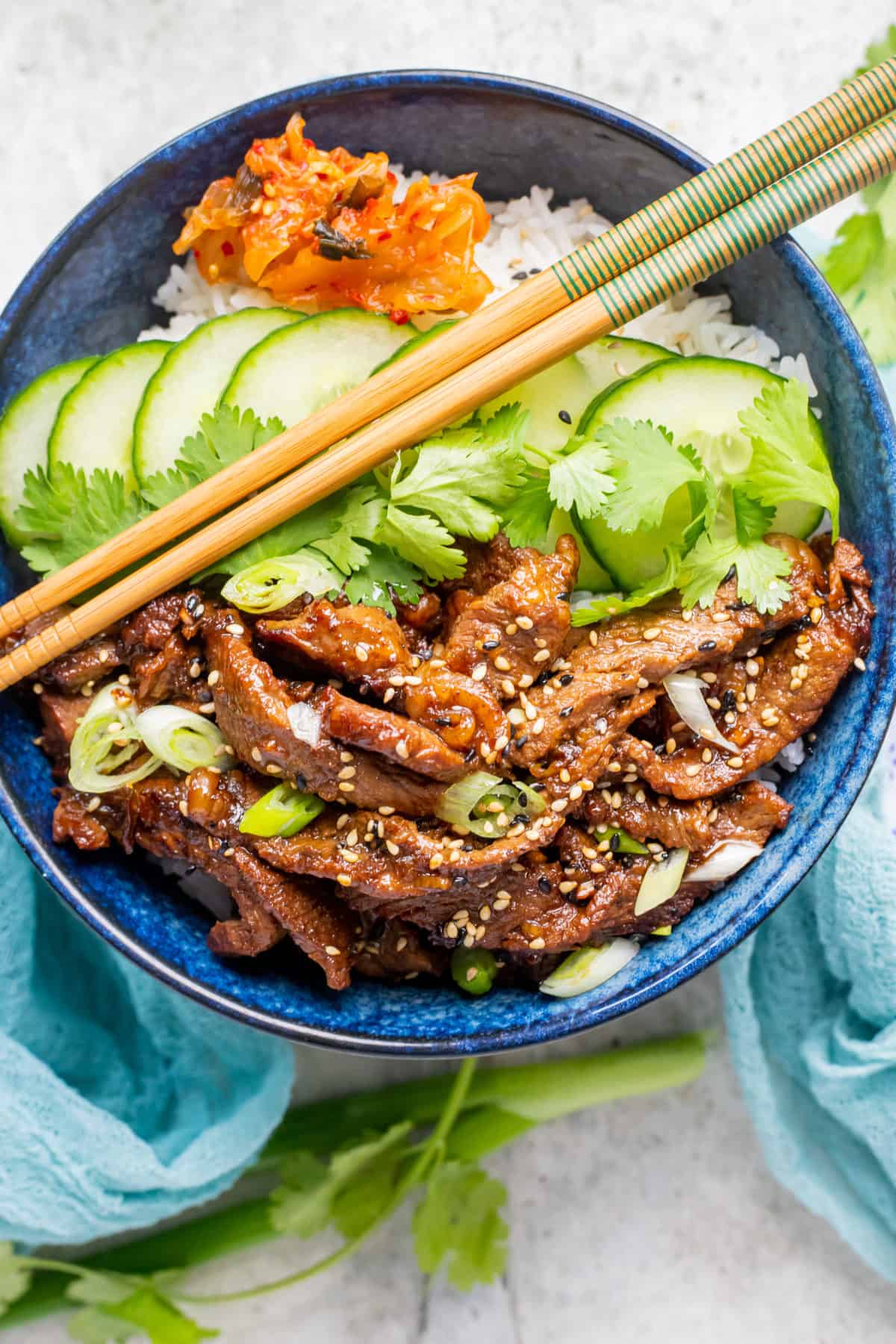
Tips for success
- For best results, make sure to slice your beef very thinly. Putting the meat in the freezer for 20 to 30 minutes before slicing helps firm it up to make it easier to slice.
- To ensure that the meat is sliced thinly enough is to purchase pre-sliced meat at an Asian grocery store or a Korean market. Bulgogi is a classic and well-loved dish for many Asian families, so most Asian grocery stores (especially a Korean grocery store) carry thinly sliced beef for the purpose of cooking Bulgogi.
- Another good idea, if you are pressed for time, is to make a ground beef version. You can make this into a ground beef bulgogi recipe by simply substituting ground beef for the sliced steak. Marinate the ground beef for 15 to 20 minutes and then stir-fry it in a large skillet. You could even substitute ground turkey or ground chicken if that’s what you have on hand.
- Mirin is a Japanese cooking wine. It is similar to sake but has more sugar and a lower alcohol content. It is a staple in most Asian pantries and you buy it in any Asian market. You can also substitute sake, Korean shochu, Shiaoxing wine, or even just a dry white wine.
To see step-by-step instructions, check out my How to Make Beef Bulgogi Bowls web story!
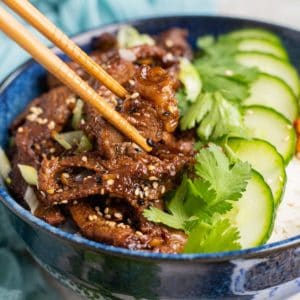
Beef Bulgogi Bowl
Ingredients
For the meat and marinade
- ½ pear Bosc or Asian pear recommended, grated
- 4 garlic cloves minced
- 2 green onions cut into 2-inch long pieces
- 5 tablespoons dark soy sauce
- 2 tablespoons sesame oil
- 3 tablespoons mirin
- 1 tablespoon rice vinegar
- 2 tablespoons honey
- 1 pound thinly sliced rib-eye steak
Instructions
- In a large bowl or a large ziploc bag, combine the pear, garlic, green onion, soy sauce, sesame oil, mirin, rice vinegar, and honey and stir or shake to mix well. Add the sliced beef to the marinade and toss to coat.
- Let the beef marinate for at least 30 minutes (or as long as 24 hours. Refrigerate if marinating more than 30 minutes).
- Preaheat the barbecue, grill, griddle, or a cast-iron skillet to high heat. Add the meat and cook, turning frequently, and cook for just about 30 seconds per side, until it is cooked through and browned and caramelized on the edges. You may need to cook the meat in batches. Transfer the cooked meat to plate and continue cooking the remaining meat.
- Serve the meat in bowls over rice. Add sliced cucumbers, cilantro, shredded carrots, sliced radishes, sliced green onions, kimchi, and a sprinkling of sesame seeds as desired.
- Serve with hot sauce, sriracha, gochujang sauce, or ssamjang, if desired.






25 thoughts on “Korean Beef Bulgogi Bowl Recipe”